ISC 205 Project: Canadian Customs Documentation and Procedures
VerifiedAdded on 2022/11/19
|14
|2078
|492
Project
AI Summary
This project comprehensively addresses Canadian customs documentation rules, procedures, and requirements for importing goods. It details the necessary shipping documents, such as the Canada customs invoice, bill of lading, and cargo control document, and explains their significance in the import process. The project outlines the steps involved in customs clearance, including obtaining a business number, identifying goods, determining the country of origin, and ensuring compliance with regulations. It also covers duty-free status under NAFTA rules of origin, the role of customs brokers, and the e-Manifest program. The project further examines the steps companies must follow upon receiving imported products, including accounting for duties and taxes, and releasing goods prior to payment. Finally, it addresses warehouse procedures and the importance of maintaining records. The assignment provides a detailed guide to navigating the complexities of Canadian customs regulations.
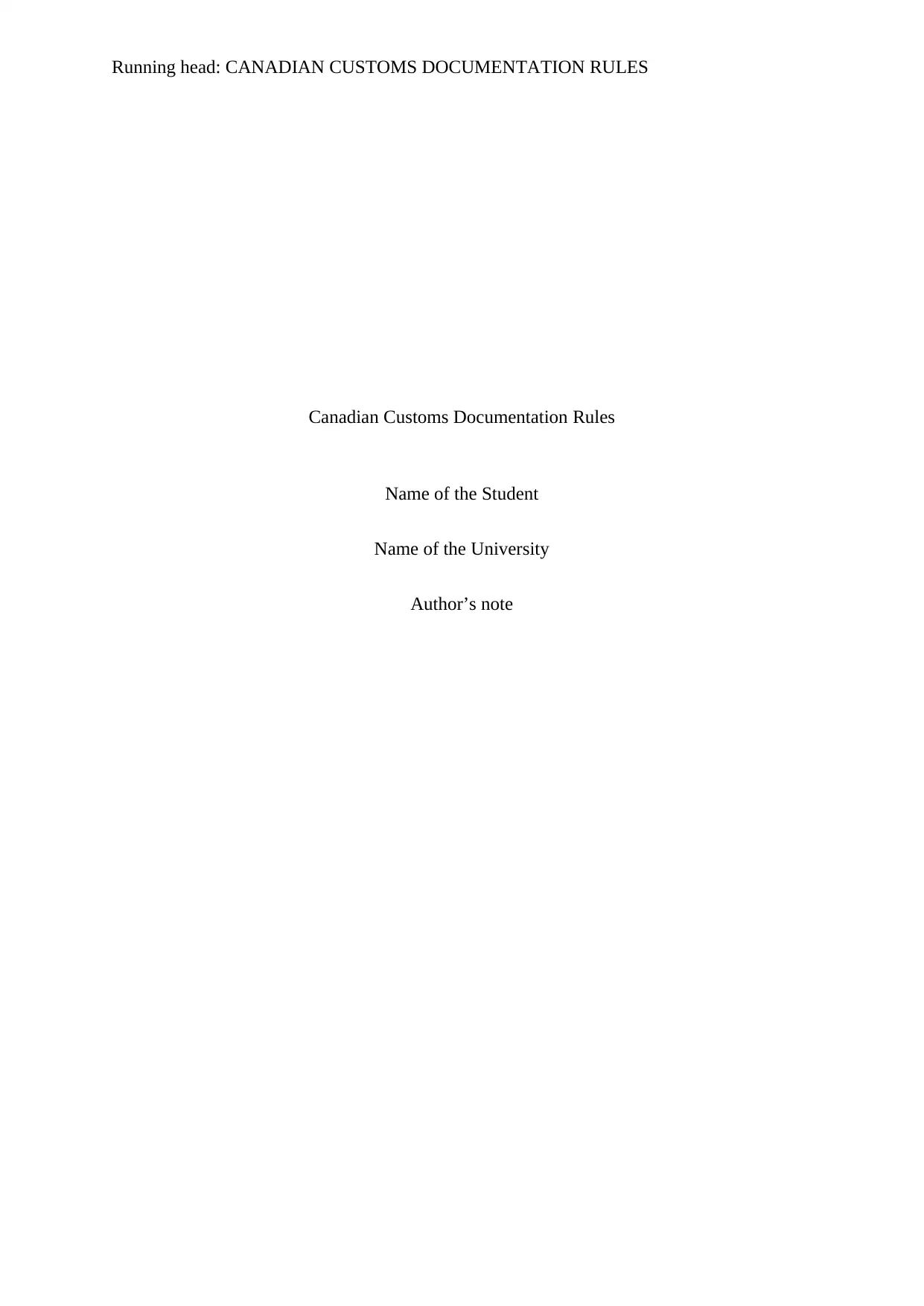
Running head: CANADIAN CUSTOMS DOCUMENTATION RULES
Canadian Customs Documentation Rules
Name of the Student
Name of the University
Author’s note
Canadian Customs Documentation Rules
Name of the Student
Name of the University
Author’s note
Paraphrase This Document
Need a fresh take? Get an instant paraphrase of this document with our AI Paraphraser
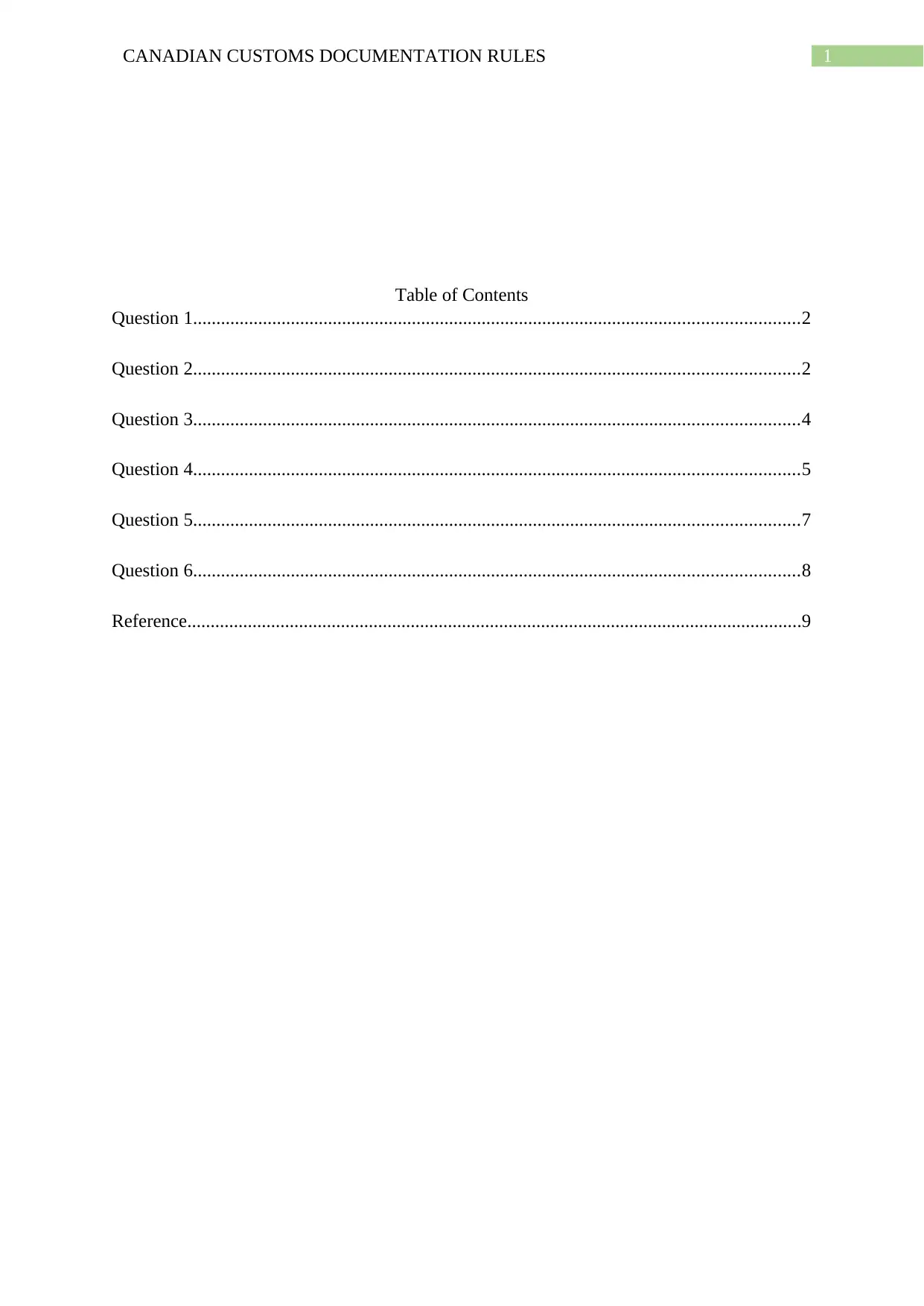
1CANADIAN CUSTOMS DOCUMENTATION RULES
Table of Contents
Question 1..................................................................................................................................2
Question 2..................................................................................................................................2
Question 3..................................................................................................................................4
Question 4..................................................................................................................................5
Question 5..................................................................................................................................7
Question 6..................................................................................................................................8
Reference....................................................................................................................................9
Table of Contents
Question 1..................................................................................................................................2
Question 2..................................................................................................................................2
Question 3..................................................................................................................................4
Question 4..................................................................................................................................5
Question 5..................................................................................................................................7
Question 6..................................................................................................................................8
Reference....................................................................................................................................9
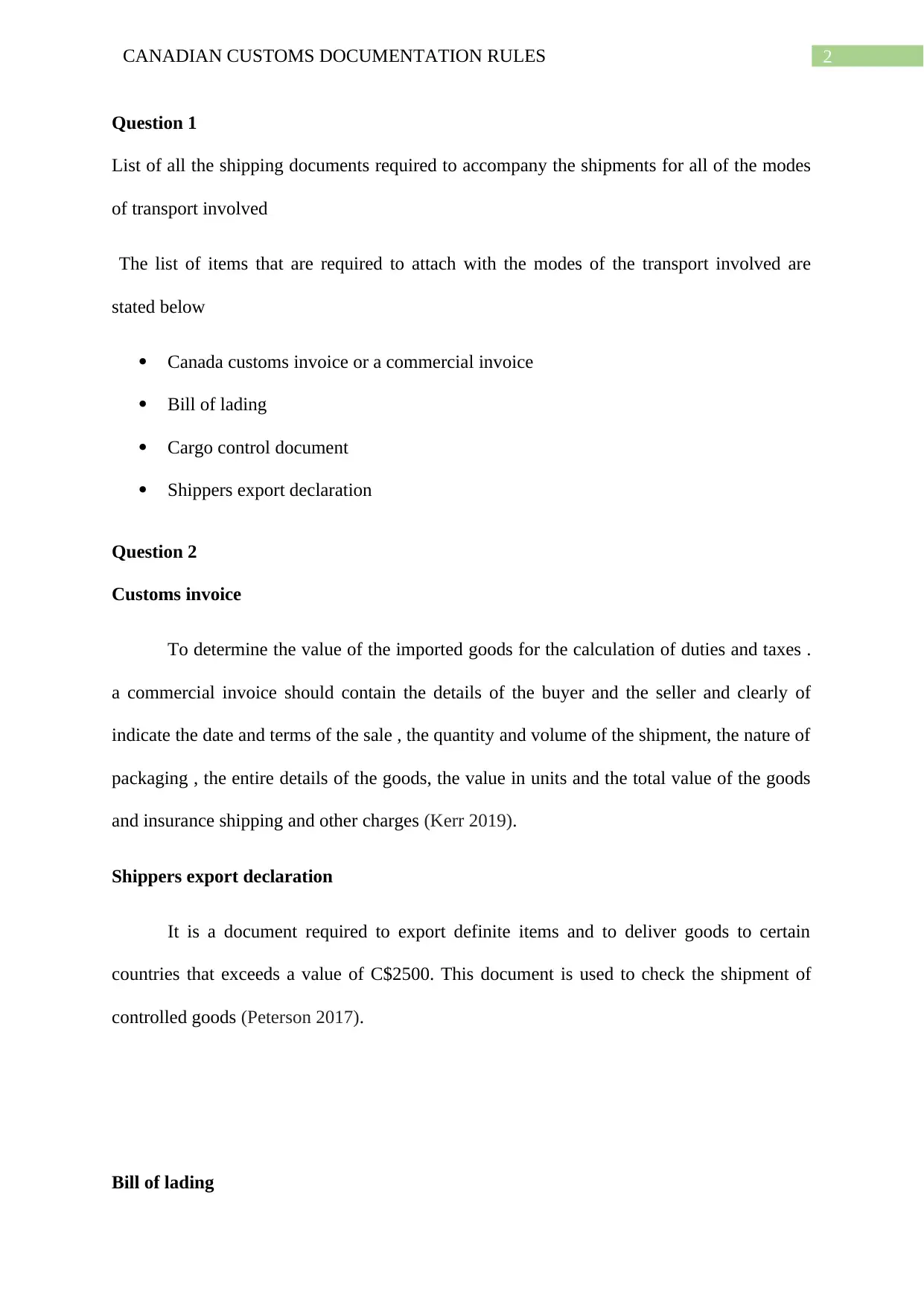
2CANADIAN CUSTOMS DOCUMENTATION RULES
Question 1
List of all the shipping documents required to accompany the shipments for all of the modes
of transport involved
The list of items that are required to attach with the modes of the transport involved are
stated below
Canada customs invoice or a commercial invoice
Bill of lading
Cargo control document
Shippers export declaration
Question 2
Customs invoice
To determine the value of the imported goods for the calculation of duties and taxes .
a commercial invoice should contain the details of the buyer and the seller and clearly of
indicate the date and terms of the sale , the quantity and volume of the shipment, the nature of
packaging , the entire details of the goods, the value in units and the total value of the goods
and insurance shipping and other charges (Kerr 2019).
Shippers export declaration
It is a document required to export definite items and to deliver goods to certain
countries that exceeds a value of C$2500. This document is used to check the shipment of
controlled goods (Peterson 2017).
Bill of lading
Question 1
List of all the shipping documents required to accompany the shipments for all of the modes
of transport involved
The list of items that are required to attach with the modes of the transport involved are
stated below
Canada customs invoice or a commercial invoice
Bill of lading
Cargo control document
Shippers export declaration
Question 2
Customs invoice
To determine the value of the imported goods for the calculation of duties and taxes .
a commercial invoice should contain the details of the buyer and the seller and clearly of
indicate the date and terms of the sale , the quantity and volume of the shipment, the nature of
packaging , the entire details of the goods, the value in units and the total value of the goods
and insurance shipping and other charges (Kerr 2019).
Shippers export declaration
It is a document required to export definite items and to deliver goods to certain
countries that exceeds a value of C$2500. This document is used to check the shipment of
controlled goods (Peterson 2017).
Bill of lading
⊘ This is a preview!⊘
Do you want full access?
Subscribe today to unlock all pages.

Trusted by 1+ million students worldwide
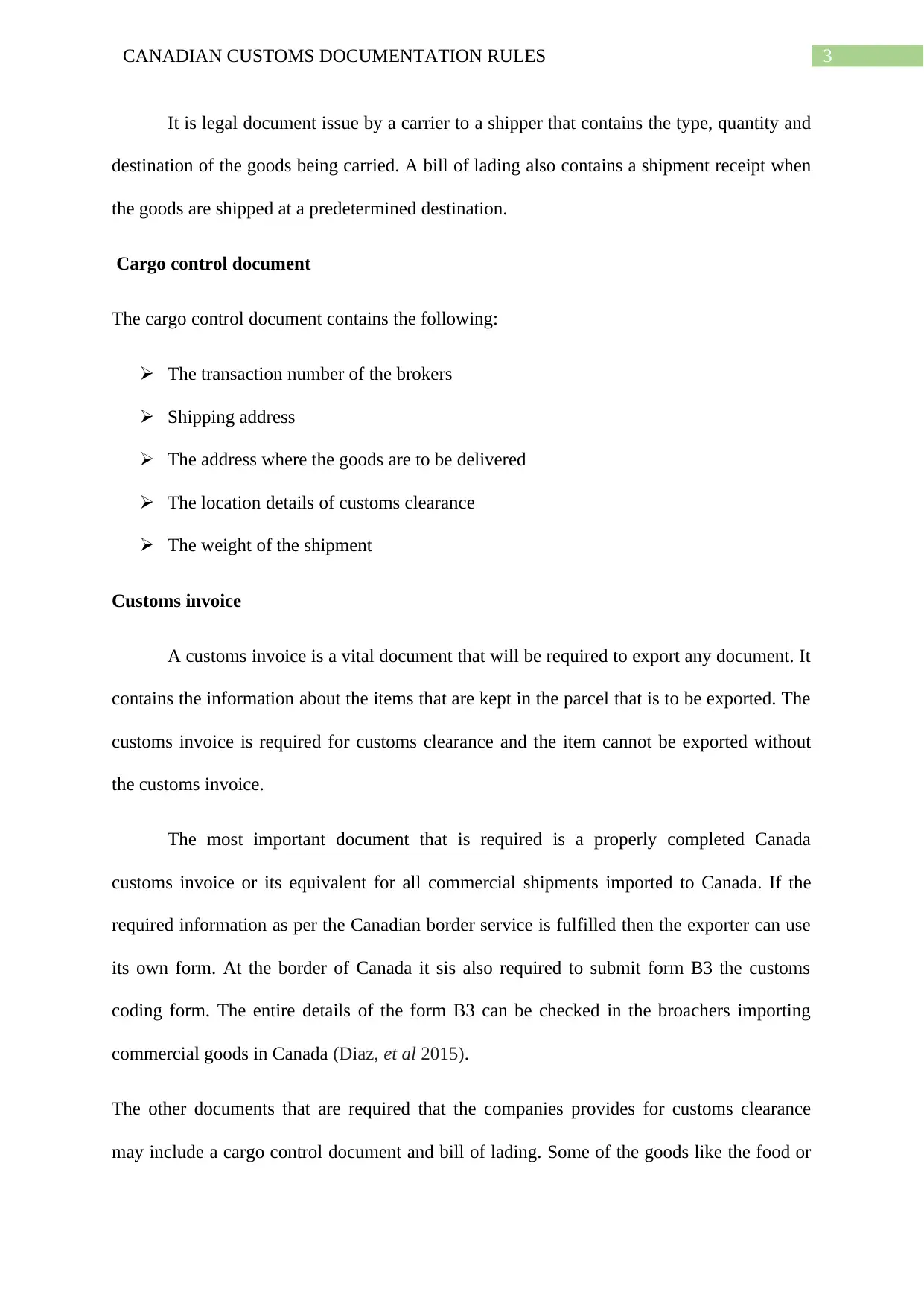
3CANADIAN CUSTOMS DOCUMENTATION RULES
It is legal document issue by a carrier to a shipper that contains the type, quantity and
destination of the goods being carried. A bill of lading also contains a shipment receipt when
the goods are shipped at a predetermined destination.
Cargo control document
The cargo control document contains the following:
The transaction number of the brokers
Shipping address
The address where the goods are to be delivered
The location details of customs clearance
The weight of the shipment
Customs invoice
A customs invoice is a vital document that will be required to export any document. It
contains the information about the items that are kept in the parcel that is to be exported. The
customs invoice is required for customs clearance and the item cannot be exported without
the customs invoice.
The most important document that is required is a properly completed Canada
customs invoice or its equivalent for all commercial shipments imported to Canada. If the
required information as per the Canadian border service is fulfilled then the exporter can use
its own form. At the border of Canada it sis also required to submit form B3 the customs
coding form. The entire details of the form B3 can be checked in the broachers importing
commercial goods in Canada (Diaz, et al 2015).
The other documents that are required that the companies provides for customs clearance
may include a cargo control document and bill of lading. Some of the goods like the food or
It is legal document issue by a carrier to a shipper that contains the type, quantity and
destination of the goods being carried. A bill of lading also contains a shipment receipt when
the goods are shipped at a predetermined destination.
Cargo control document
The cargo control document contains the following:
The transaction number of the brokers
Shipping address
The address where the goods are to be delivered
The location details of customs clearance
The weight of the shipment
Customs invoice
A customs invoice is a vital document that will be required to export any document. It
contains the information about the items that are kept in the parcel that is to be exported. The
customs invoice is required for customs clearance and the item cannot be exported without
the customs invoice.
The most important document that is required is a properly completed Canada
customs invoice or its equivalent for all commercial shipments imported to Canada. If the
required information as per the Canadian border service is fulfilled then the exporter can use
its own form. At the border of Canada it sis also required to submit form B3 the customs
coding form. The entire details of the form B3 can be checked in the broachers importing
commercial goods in Canada (Diaz, et al 2015).
The other documents that are required that the companies provides for customs clearance
may include a cargo control document and bill of lading. Some of the goods like the food or
Paraphrase This Document
Need a fresh take? Get an instant paraphrase of this document with our AI Paraphraser
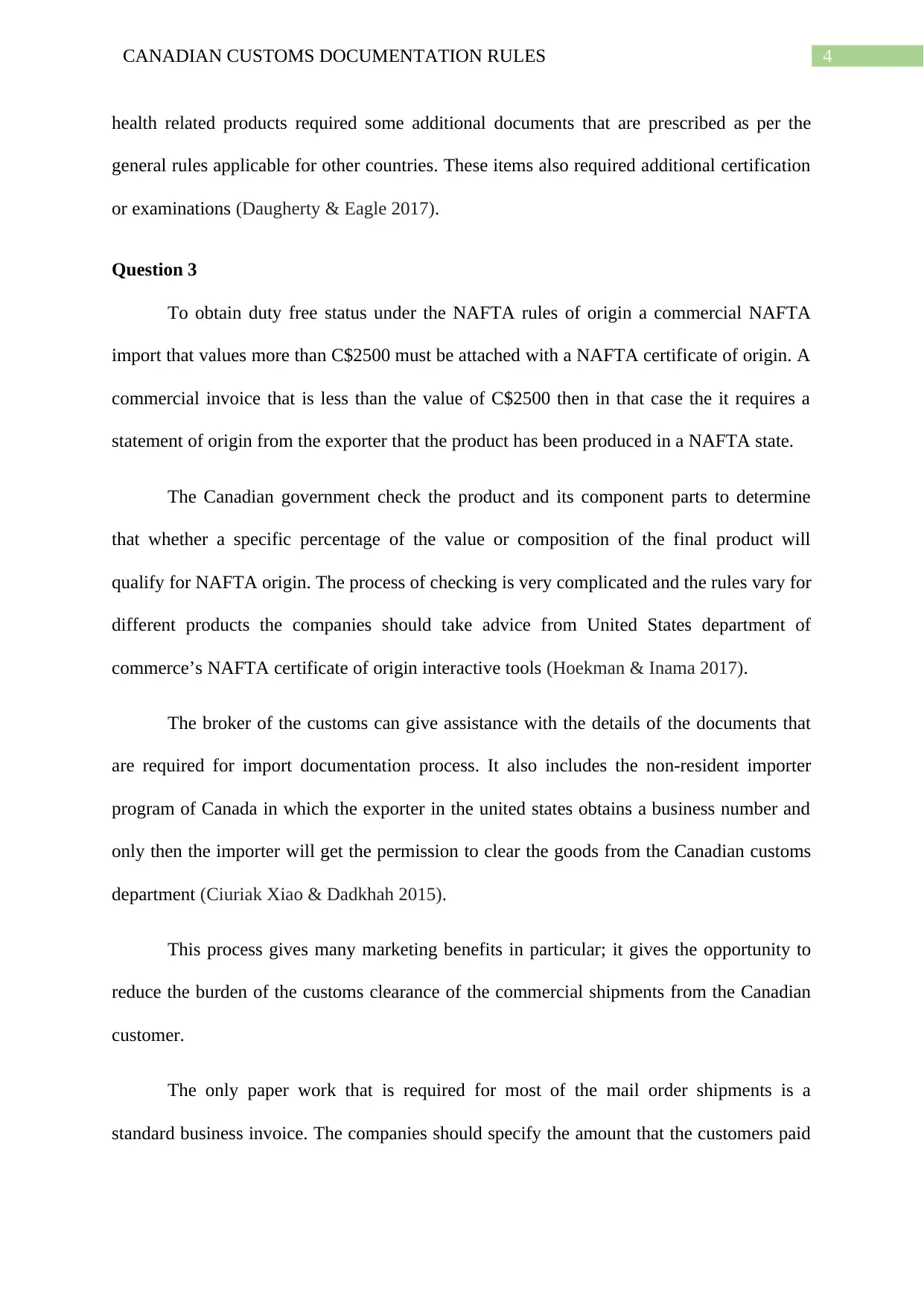
4CANADIAN CUSTOMS DOCUMENTATION RULES
health related products required some additional documents that are prescribed as per the
general rules applicable for other countries. These items also required additional certification
or examinations (Daugherty & Eagle 2017).
Question 3
To obtain duty free status under the NAFTA rules of origin a commercial NAFTA
import that values more than C$2500 must be attached with a NAFTA certificate of origin. A
commercial invoice that is less than the value of C$2500 then in that case the it requires a
statement of origin from the exporter that the product has been produced in a NAFTA state.
The Canadian government check the product and its component parts to determine
that whether a specific percentage of the value or composition of the final product will
qualify for NAFTA origin. The process of checking is very complicated and the rules vary for
different products the companies should take advice from United States department of
commerce’s NAFTA certificate of origin interactive tools (Hoekman & Inama 2017).
The broker of the customs can give assistance with the details of the documents that
are required for import documentation process. It also includes the non-resident importer
program of Canada in which the exporter in the united states obtains a business number and
only then the importer will get the permission to clear the goods from the Canadian customs
department (Ciuriak Xiao & Dadkhah 2015).
This process gives many marketing benefits in particular; it gives the opportunity to
reduce the burden of the customs clearance of the commercial shipments from the Canadian
customer.
The only paper work that is required for most of the mail order shipments is a
standard business invoice. The companies should specify the amount that the customers paid
health related products required some additional documents that are prescribed as per the
general rules applicable for other countries. These items also required additional certification
or examinations (Daugherty & Eagle 2017).
Question 3
To obtain duty free status under the NAFTA rules of origin a commercial NAFTA
import that values more than C$2500 must be attached with a NAFTA certificate of origin. A
commercial invoice that is less than the value of C$2500 then in that case the it requires a
statement of origin from the exporter that the product has been produced in a NAFTA state.
The Canadian government check the product and its component parts to determine
that whether a specific percentage of the value or composition of the final product will
qualify for NAFTA origin. The process of checking is very complicated and the rules vary for
different products the companies should take advice from United States department of
commerce’s NAFTA certificate of origin interactive tools (Hoekman & Inama 2017).
The broker of the customs can give assistance with the details of the documents that
are required for import documentation process. It also includes the non-resident importer
program of Canada in which the exporter in the united states obtains a business number and
only then the importer will get the permission to clear the goods from the Canadian customs
department (Ciuriak Xiao & Dadkhah 2015).
This process gives many marketing benefits in particular; it gives the opportunity to
reduce the burden of the customs clearance of the commercial shipments from the Canadian
customer.
The only paper work that is required for most of the mail order shipments is a
standard business invoice. The companies should specify the amount that the customers paid
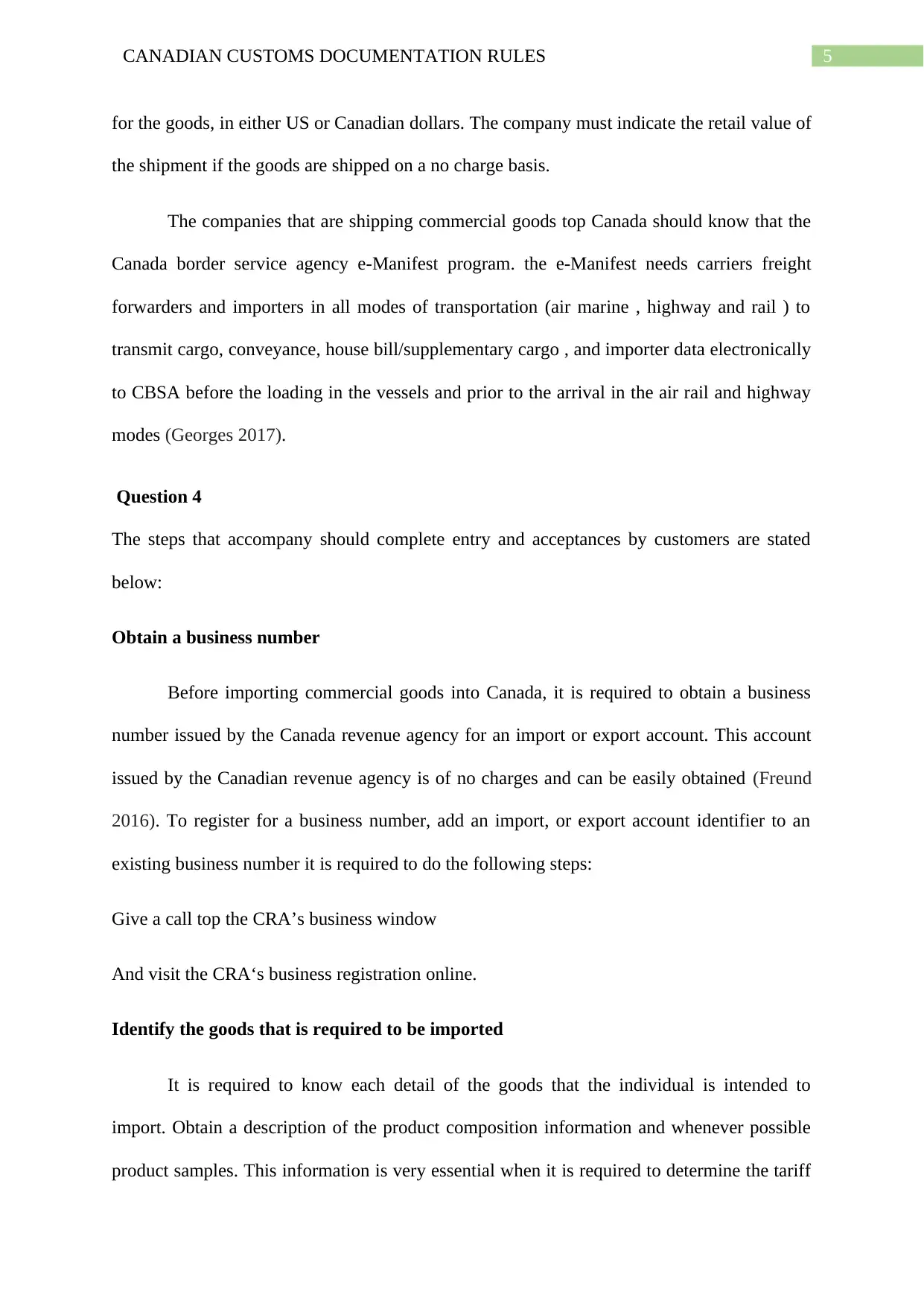
5CANADIAN CUSTOMS DOCUMENTATION RULES
for the goods, in either US or Canadian dollars. The company must indicate the retail value of
the shipment if the goods are shipped on a no charge basis.
The companies that are shipping commercial goods top Canada should know that the
Canada border service agency e-Manifest program. the e-Manifest needs carriers freight
forwarders and importers in all modes of transportation (air marine , highway and rail ) to
transmit cargo, conveyance, house bill/supplementary cargo , and importer data electronically
to CBSA before the loading in the vessels and prior to the arrival in the air rail and highway
modes (Georges 2017).
Question 4
The steps that accompany should complete entry and acceptances by customers are stated
below:
Obtain a business number
Before importing commercial goods into Canada, it is required to obtain a business
number issued by the Canada revenue agency for an import or export account. This account
issued by the Canadian revenue agency is of no charges and can be easily obtained (Freund
2016). To register for a business number, add an import, or export account identifier to an
existing business number it is required to do the following steps:
Give a call top the CRA’s business window
And visit the CRA‘s business registration online.
Identify the goods that is required to be imported
It is required to know each detail of the goods that the individual is intended to
import. Obtain a description of the product composition information and whenever possible
product samples. This information is very essential when it is required to determine the tariff
for the goods, in either US or Canadian dollars. The company must indicate the retail value of
the shipment if the goods are shipped on a no charge basis.
The companies that are shipping commercial goods top Canada should know that the
Canada border service agency e-Manifest program. the e-Manifest needs carriers freight
forwarders and importers in all modes of transportation (air marine , highway and rail ) to
transmit cargo, conveyance, house bill/supplementary cargo , and importer data electronically
to CBSA before the loading in the vessels and prior to the arrival in the air rail and highway
modes (Georges 2017).
Question 4
The steps that accompany should complete entry and acceptances by customers are stated
below:
Obtain a business number
Before importing commercial goods into Canada, it is required to obtain a business
number issued by the Canada revenue agency for an import or export account. This account
issued by the Canadian revenue agency is of no charges and can be easily obtained (Freund
2016). To register for a business number, add an import, or export account identifier to an
existing business number it is required to do the following steps:
Give a call top the CRA’s business window
And visit the CRA‘s business registration online.
Identify the goods that is required to be imported
It is required to know each detail of the goods that the individual is intended to
import. Obtain a description of the product composition information and whenever possible
product samples. This information is very essential when it is required to determine the tariff
⊘ This is a preview!⊘
Do you want full access?
Subscribe today to unlock all pages.

Trusted by 1+ million students worldwide
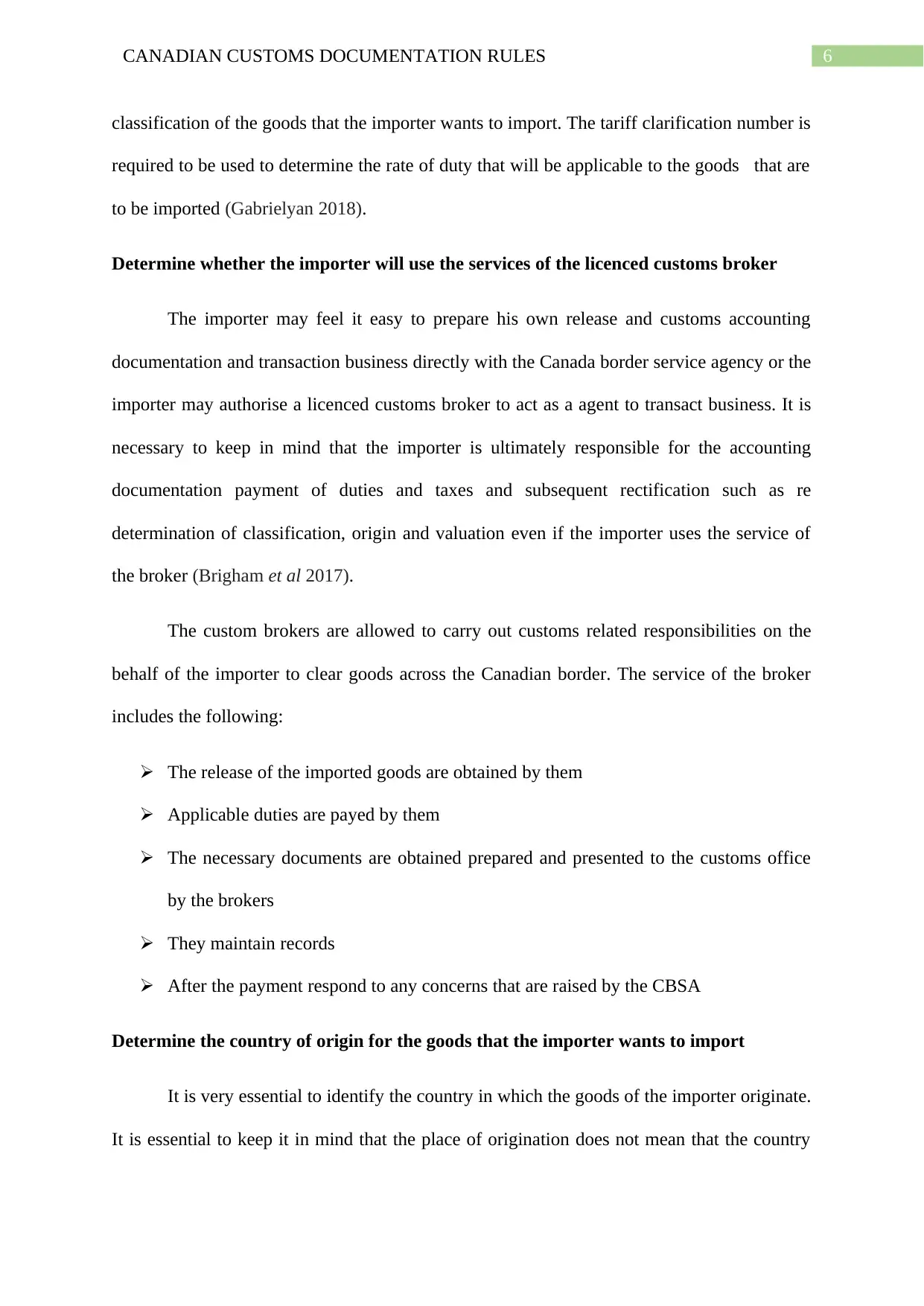
6CANADIAN CUSTOMS DOCUMENTATION RULES
classification of the goods that the importer wants to import. The tariff clarification number is
required to be used to determine the rate of duty that will be applicable to the goods that are
to be imported (Gabrielyan 2018).
Determine whether the importer will use the services of the licenced customs broker
The importer may feel it easy to prepare his own release and customs accounting
documentation and transaction business directly with the Canada border service agency or the
importer may authorise a licenced customs broker to act as a agent to transact business. It is
necessary to keep in mind that the importer is ultimately responsible for the accounting
documentation payment of duties and taxes and subsequent rectification such as re
determination of classification, origin and valuation even if the importer uses the service of
the broker (Brigham et al 2017).
The custom brokers are allowed to carry out customs related responsibilities on the
behalf of the importer to clear goods across the Canadian border. The service of the broker
includes the following:
The release of the imported goods are obtained by them
Applicable duties are payed by them
The necessary documents are obtained prepared and presented to the customs office
by the brokers
They maintain records
After the payment respond to any concerns that are raised by the CBSA
Determine the country of origin for the goods that the importer wants to import
It is very essential to identify the country in which the goods of the importer originate.
It is essential to keep it in mind that the place of origination does not mean that the country
classification of the goods that the importer wants to import. The tariff clarification number is
required to be used to determine the rate of duty that will be applicable to the goods that are
to be imported (Gabrielyan 2018).
Determine whether the importer will use the services of the licenced customs broker
The importer may feel it easy to prepare his own release and customs accounting
documentation and transaction business directly with the Canada border service agency or the
importer may authorise a licenced customs broker to act as a agent to transact business. It is
necessary to keep in mind that the importer is ultimately responsible for the accounting
documentation payment of duties and taxes and subsequent rectification such as re
determination of classification, origin and valuation even if the importer uses the service of
the broker (Brigham et al 2017).
The custom brokers are allowed to carry out customs related responsibilities on the
behalf of the importer to clear goods across the Canadian border. The service of the broker
includes the following:
The release of the imported goods are obtained by them
Applicable duties are payed by them
The necessary documents are obtained prepared and presented to the customs office
by the brokers
They maintain records
After the payment respond to any concerns that are raised by the CBSA
Determine the country of origin for the goods that the importer wants to import
It is very essential to identify the country in which the goods of the importer originate.
It is essential to keep it in mind that the place of origination does not mean that the country
Paraphrase This Document
Need a fresh take? Get an instant paraphrase of this document with our AI Paraphraser
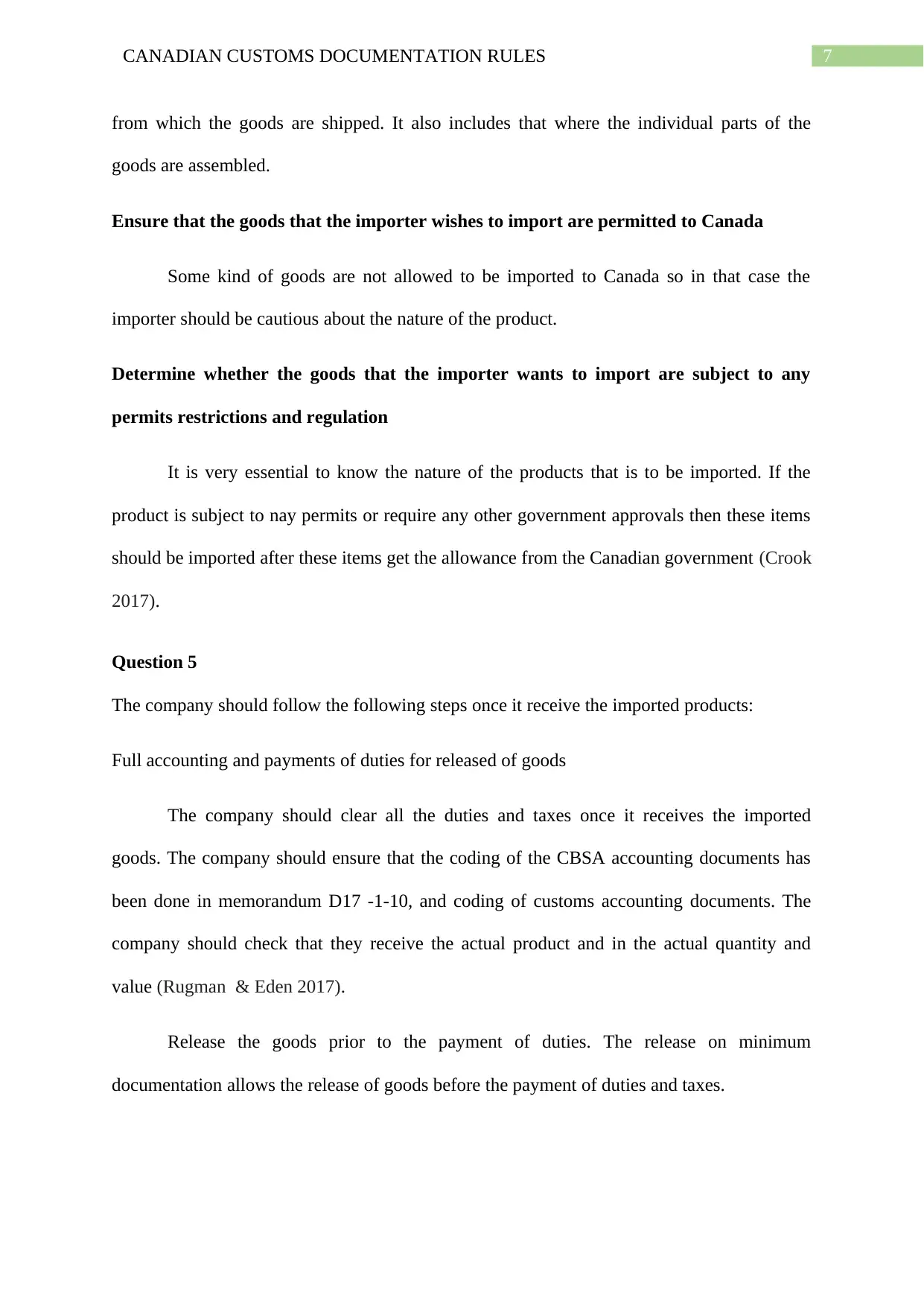
7CANADIAN CUSTOMS DOCUMENTATION RULES
from which the goods are shipped. It also includes that where the individual parts of the
goods are assembled.
Ensure that the goods that the importer wishes to import are permitted to Canada
Some kind of goods are not allowed to be imported to Canada so in that case the
importer should be cautious about the nature of the product.
Determine whether the goods that the importer wants to import are subject to any
permits restrictions and regulation
It is very essential to know the nature of the products that is to be imported. If the
product is subject to nay permits or require any other government approvals then these items
should be imported after these items get the allowance from the Canadian government (Crook
2017).
Question 5
The company should follow the following steps once it receive the imported products:
Full accounting and payments of duties for released of goods
The company should clear all the duties and taxes once it receives the imported
goods. The company should ensure that the coding of the CBSA accounting documents has
been done in memorandum D17 -1-10, and coding of customs accounting documents. The
company should check that they receive the actual product and in the actual quantity and
value (Rugman & Eden 2017).
Release the goods prior to the payment of duties. The release on minimum
documentation allows the release of goods before the payment of duties and taxes.
from which the goods are shipped. It also includes that where the individual parts of the
goods are assembled.
Ensure that the goods that the importer wishes to import are permitted to Canada
Some kind of goods are not allowed to be imported to Canada so in that case the
importer should be cautious about the nature of the product.
Determine whether the goods that the importer wants to import are subject to any
permits restrictions and regulation
It is very essential to know the nature of the products that is to be imported. If the
product is subject to nay permits or require any other government approvals then these items
should be imported after these items get the allowance from the Canadian government (Crook
2017).
Question 5
The company should follow the following steps once it receive the imported products:
Full accounting and payments of duties for released of goods
The company should clear all the duties and taxes once it receives the imported
goods. The company should ensure that the coding of the CBSA accounting documents has
been done in memorandum D17 -1-10, and coding of customs accounting documents. The
company should check that they receive the actual product and in the actual quantity and
value (Rugman & Eden 2017).
Release the goods prior to the payment of duties. The release on minimum
documentation allows the release of goods before the payment of duties and taxes.
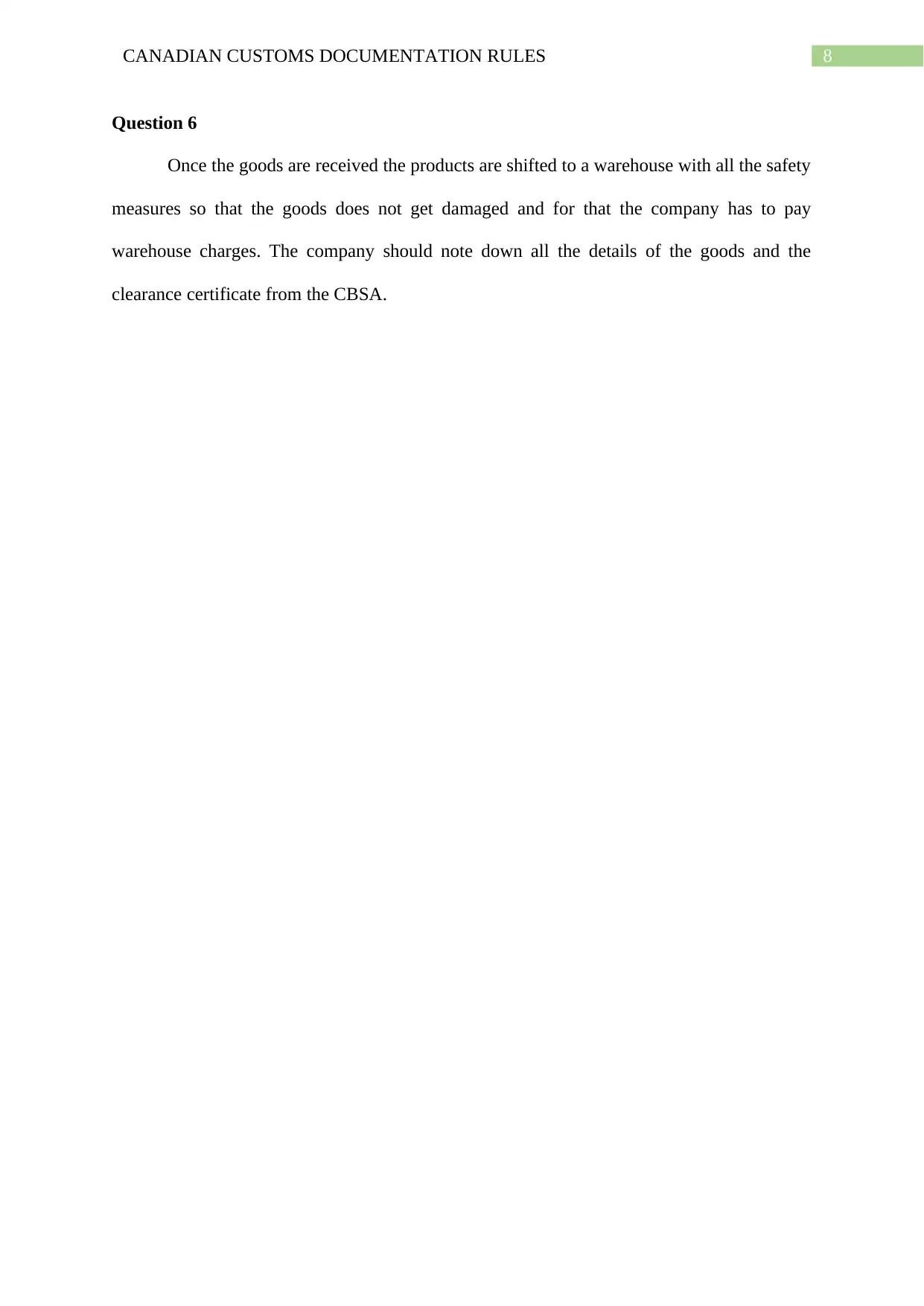
8CANADIAN CUSTOMS DOCUMENTATION RULES
Question 6
Once the goods are received the products are shifted to a warehouse with all the safety
measures so that the goods does not get damaged and for that the company has to pay
warehouse charges. The company should note down all the details of the goods and the
clearance certificate from the CBSA.
Question 6
Once the goods are received the products are shifted to a warehouse with all the safety
measures so that the goods does not get damaged and for that the company has to pay
warehouse charges. The company should note down all the details of the goods and the
clearance certificate from the CBSA.
⊘ This is a preview!⊘
Do you want full access?
Subscribe today to unlock all pages.

Trusted by 1+ million students worldwide
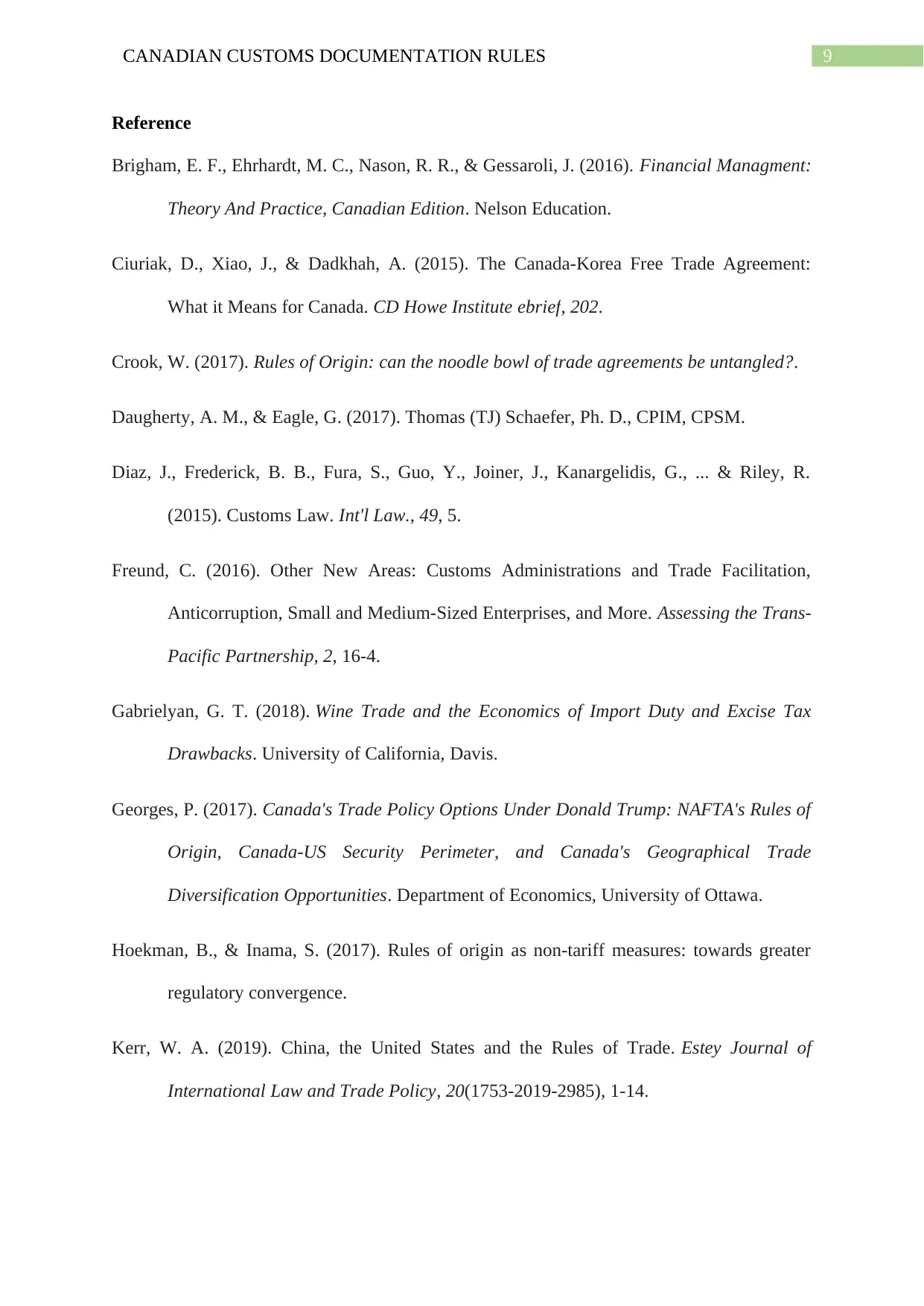
9CANADIAN CUSTOMS DOCUMENTATION RULES
Reference
Brigham, E. F., Ehrhardt, M. C., Nason, R. R., & Gessaroli, J. (2016). Financial Managment:
Theory And Practice, Canadian Edition. Nelson Education.
Ciuriak, D., Xiao, J., & Dadkhah, A. (2015). The Canada-Korea Free Trade Agreement:
What it Means for Canada. CD Howe Institute ebrief, 202.
Crook, W. (2017). Rules of Origin: can the noodle bowl of trade agreements be untangled?.
Daugherty, A. M., & Eagle, G. (2017). Thomas (TJ) Schaefer, Ph. D., CPIM, CPSM.
Diaz, J., Frederick, B. B., Fura, S., Guo, Y., Joiner, J., Kanargelidis, G., ... & Riley, R.
(2015). Customs Law. Int'l Law., 49, 5.
Freund, C. (2016). Other New Areas: Customs Administrations and Trade Facilitation,
Anticorruption, Small and Medium-Sized Enterprises, and More. Assessing the Trans-
Pacific Partnership, 2, 16-4.
Gabrielyan, G. T. (2018). Wine Trade and the Economics of Import Duty and Excise Tax
Drawbacks. University of California, Davis.
Georges, P. (2017). Canada's Trade Policy Options Under Donald Trump: NAFTA's Rules of
Origin, Canada-US Security Perimeter, and Canada's Geographical Trade
Diversification Opportunities. Department of Economics, University of Ottawa.
Hoekman, B., & Inama, S. (2017). Rules of origin as non-tariff measures: towards greater
regulatory convergence.
Kerr, W. A. (2019). China, the United States and the Rules of Trade. Estey Journal of
International Law and Trade Policy, 20(1753-2019-2985), 1-14.
Reference
Brigham, E. F., Ehrhardt, M. C., Nason, R. R., & Gessaroli, J. (2016). Financial Managment:
Theory And Practice, Canadian Edition. Nelson Education.
Ciuriak, D., Xiao, J., & Dadkhah, A. (2015). The Canada-Korea Free Trade Agreement:
What it Means for Canada. CD Howe Institute ebrief, 202.
Crook, W. (2017). Rules of Origin: can the noodle bowl of trade agreements be untangled?.
Daugherty, A. M., & Eagle, G. (2017). Thomas (TJ) Schaefer, Ph. D., CPIM, CPSM.
Diaz, J., Frederick, B. B., Fura, S., Guo, Y., Joiner, J., Kanargelidis, G., ... & Riley, R.
(2015). Customs Law. Int'l Law., 49, 5.
Freund, C. (2016). Other New Areas: Customs Administrations and Trade Facilitation,
Anticorruption, Small and Medium-Sized Enterprises, and More. Assessing the Trans-
Pacific Partnership, 2, 16-4.
Gabrielyan, G. T. (2018). Wine Trade and the Economics of Import Duty and Excise Tax
Drawbacks. University of California, Davis.
Georges, P. (2017). Canada's Trade Policy Options Under Donald Trump: NAFTA's Rules of
Origin, Canada-US Security Perimeter, and Canada's Geographical Trade
Diversification Opportunities. Department of Economics, University of Ottawa.
Hoekman, B., & Inama, S. (2017). Rules of origin as non-tariff measures: towards greater
regulatory convergence.
Kerr, W. A. (2019). China, the United States and the Rules of Trade. Estey Journal of
International Law and Trade Policy, 20(1753-2019-2985), 1-14.
Paraphrase This Document
Need a fresh take? Get an instant paraphrase of this document with our AI Paraphraser
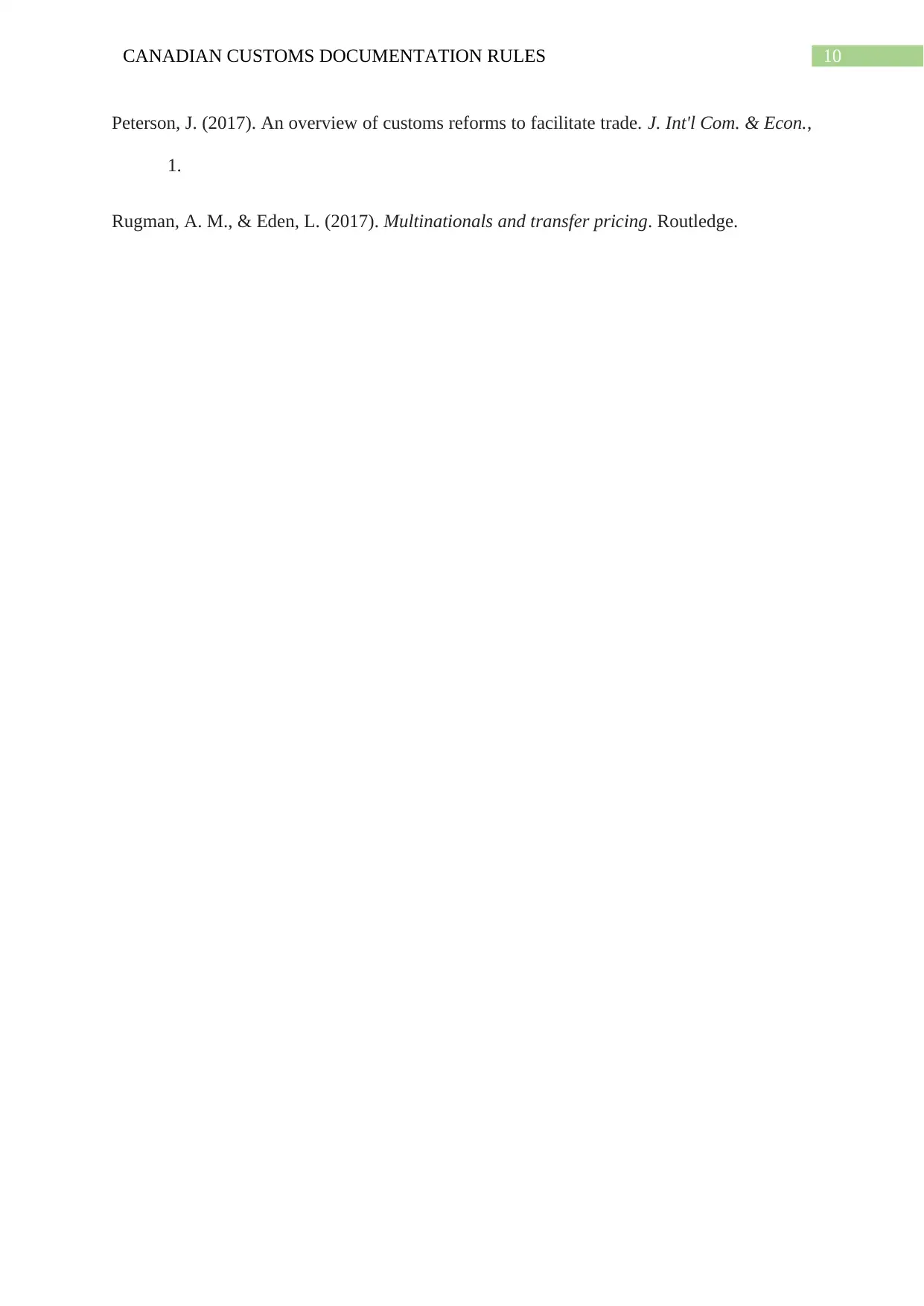
10CANADIAN CUSTOMS DOCUMENTATION RULES
Peterson, J. (2017). An overview of customs reforms to facilitate trade. J. Int'l Com. & Econ.,
1.
Rugman, A. M., & Eden, L. (2017). Multinationals and transfer pricing. Routledge.
Peterson, J. (2017). An overview of customs reforms to facilitate trade. J. Int'l Com. & Econ.,
1.
Rugman, A. M., & Eden, L. (2017). Multinationals and transfer pricing. Routledge.
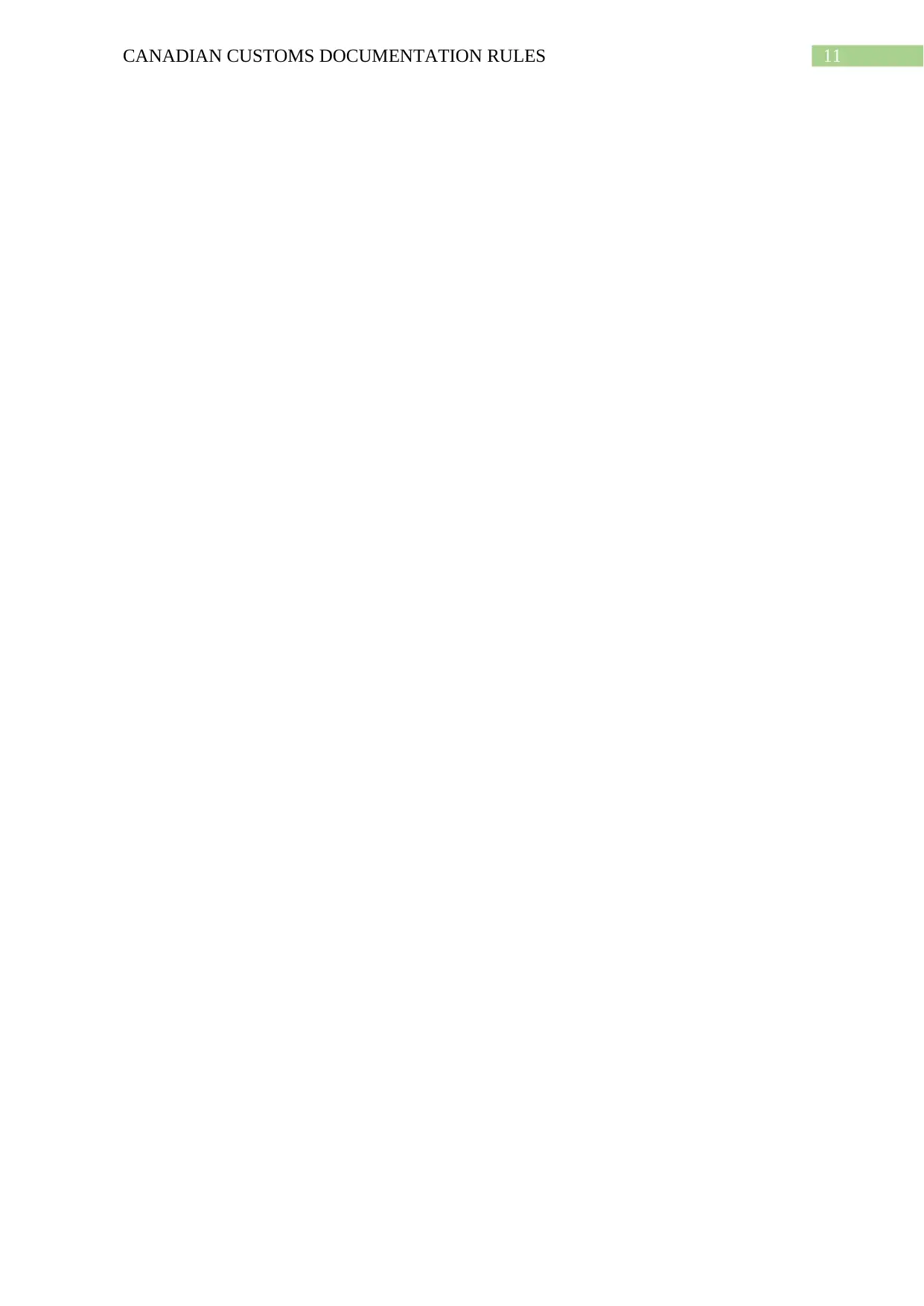
11CANADIAN CUSTOMS DOCUMENTATION RULES
⊘ This is a preview!⊘
Do you want full access?
Subscribe today to unlock all pages.

Trusted by 1+ million students worldwide
1 out of 14
Related Documents
Your All-in-One AI-Powered Toolkit for Academic Success.
+13062052269
info@desklib.com
Available 24*7 on WhatsApp / Email
![[object Object]](/_next/static/media/star-bottom.7253800d.svg)
Unlock your academic potential
Copyright © 2020–2025 A2Z Services. All Rights Reserved. Developed and managed by ZUCOL.





